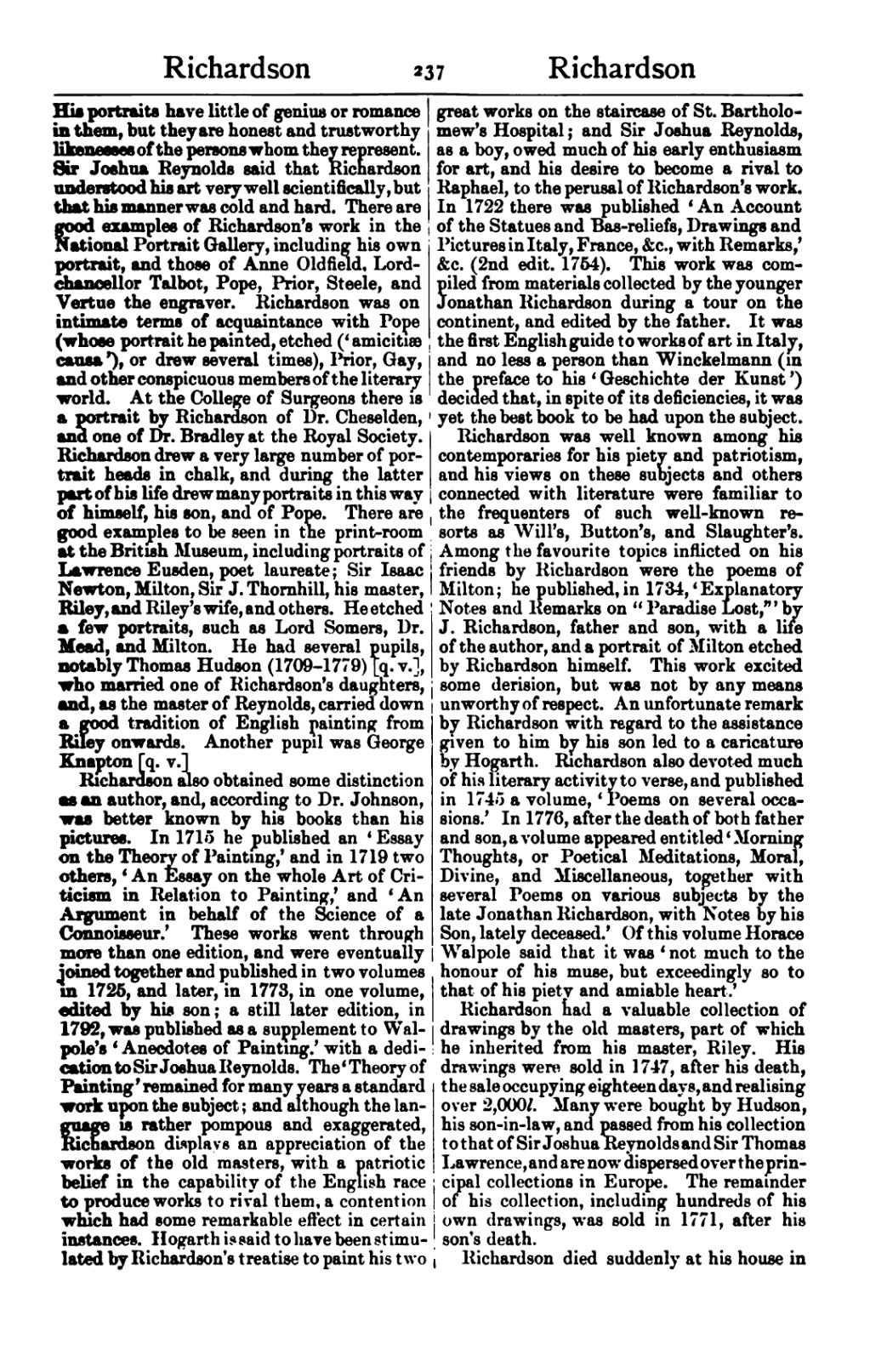His portraits have little of genius or romance in them, but they are honest and trustworthy likenesses of the persons whom they represent. Sir Joshua Reynolds said that Richardson understood his art very well scientifically, but that his manner was cold and hard. There are good examples of Richardson's work in the National Portrait Gallery, including his own portrait, and those of Anne Oldfield, Lord-Chancellor Talbot, Pope, Prior, Steele, and Vertue the engraver. Richardson was on intimate terms of acquaintance with Pope (whose portrait he painted, etched ('amicitiæ causa'), or drew several times), Prior, Gay, and other conspicuous members of the literary world. At the College of Surgeons there is a portrait by Richardson of Dr. Cheselden, and one of Dr. Bradley at the Royal Society. Richardson drew a very large number of portrait heads in chalk, and during the latter part of his life drew many portraits in this way of himself, his son, and of Pope. There are good examples to be seen in the print-room at the British Museum, including portraits of Lawrence Eusden, poet laureate; Sir Isaac Newton, Milton, Sir J. Thornhill, his master, Riley, and Riley's wife, and others. He etched a few portraits, such as Lord Somers, Dr. Mead, and Milton. He had several pupils, notably Thomas Hudson (1709-1779) [q.v.], who married one of Richardson's daughters, and, as the master of Reynolds, carried down a good tradition of English painting from Riley onwards. Another pupil was George Knapton [q. v.]
Richardson also obtained some distinction as an author, and, according to Dr. Johnson, was better known by his books than his pictures. In 1715 he published an 'Essay on the Theory of Painting,' and in 1719 two others, 'An Essay on the whole Art of Criticism in Relation to Painting,' and 'An Argument in behalf of the Science of a Connoisseur.' These works went through more than one edition, and were eventually joined together and published in two volumes in 1726, and later, in 1773, in one volume, edited by his son; a still later edition, in 1792, was published as a supplement to Walpole's 'Anecdotes of Painting.' with a dedication to Sir Joshua Reynolds. The 'Theory of Painting' remained for many years a standard work upon the subject; and although the language is rather pompous and exaggerated, Richardson displays an appreciation of the works of the old masters, with a patriotic belief in the capability of the English race to produce works to rival them, a contention which had some remarkable effect in certain instances. Hogarth is said to have been stimulated by Richardson's treatise to paint his two great works on the staircase of St. Bartholomew's Hospital; and Sir Joshua Reynolds, as a boy, owed much of his early enthusiasm for art, and his desire to become a rival to Raphael, to the perusal of Richardson's work. In 1722 there was published 'An Account of the Statues and Bas-reliefs, Drawings and Pictures in Italy, France, &c., with Remarks,' &c. (2nd edit. 1754). This work was compiled from materials collected by the younger Jonathan Richardson during a tour on the continent, and edited by the father. It was the first English guide to works of art in Italy, and no less a person than Winckelmann (in the preface to his 'Geschichte der Kunst') declared that, in spite of its deficiencies, it was yet the best book to be had upon the subject.
Richardson was well known among his contemporaries for his piety and patriotism, and his views on these subjects and others connected with literature were familiar to the frequenters of such well-known resorts as Will's, Button's, and Slaughter's. Among the favourite topics inflicted on his friends by Richardson were the poems of Milton; he published, in 1734, 'Explanatory Notes and Remarks on "Paradise Lost,"' by J. Richardson, father and son, with a life of the author, and a portrait of Milton etched by Richardson himself. This work excited some derision, but was not by any means unworthy of respect. An unfortunate remark by Richardson with regard to the assistance given to him by his son led to a caricature by Hogarth. Richardson also devote much of his literary activity to verse, and published in 1745 a volume, 'Poems on several occasions.' In 1776, after the death of both father and son, a volume appeared entitled 'Morning Thoughts, or Poetical Meditations, Moral, Divine, and Miscellaneous, together with several Poems on various subjects by the late Jonathan Richardson, with Notes by his Son, lately deceased.' Of this volume Horace Walpole said that it was 'not much to the honour of his muse, but exceedingly so to that of his piety and amiable heart.'
Richardson had a valuable collection of drawings by the old masters, part of which he inherited from his master, Riley. His drawings were sold in 1747, after his death, the sale occupying eighteen days, and realising over 2,000l. Many were bought by Hudson, his son-in-law, and passed from his collection to that of Sir Joshua Reynolds and Sir Thomas Lawrence, and are now dispersed over the principal collections in Europe. The remainder of his collection, including hundreds of his own drawings, was sold in 1771, after his son's death.
Richardson died suddenly at his house in
